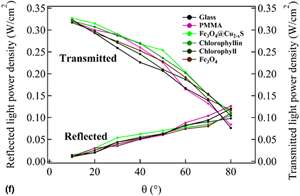Article contents
Light angle dependence of photothermal properties in oxide and porphyrin thin films for energy-efficient window applications
Published online by Cambridge University Press: 09 June 2020
Abstract

The photothermal experiments on the incident light angle dependence are carried out using simulated solar light on thin films of both iron oxides (Fe3O4 and Fe3O4@Cu2-xS) and porphyrin compounds (chlorophyll and chlorophyllin). Fe3O4 and Fe3O4@Cu2-xS are synthesized using various solution methods that produce mono-dispersed nanoparticles on the order of 10 nm. Chlorophyll is extracted from fresh spinach and chlorophyllin sodium copper is a commercial product. These photothermal (PT) materials are dispersed in polymethyl methacrylate (PMMA) solutions and deposited on glass substrates via spin coating that result in clear and transparent thin films. The iron-oxide based thin films show distinctive absorption spectra; Fe3O4 exhibits a strong peak near UV and gradually decreases into the visible and NIR regions; the absorption of Fe3O4@Cu2-xS is similar in the UV region but shows a broad absorption in the NIR region. Both chlorophyll and chlorophyllin are characterized with absorption peaks near UV and NIR showing a “U”-shaped spectrum, ideally required for efficient solar harvest and high transparency in energy-efficient single-pane window applications. Upon coating of the transparent PT films on the window inner surfaces, solar irradiation induces the photothermal effect, consequently raising the film temperature. In this fashion, the thermal loss through the window can be significantly lowered by reducing the temperature difference between the window inner surface and the room interior, based on a new concept of so-called optical thermal insulation (OTI) without any intervention medium, such as air/argon, as required in the glazing technologies. Single-panes are therefore possible to replace double- or triple panes. As OTI is inevitably affected by seasonal and daily sunlight changes, an incident light angle dependence of the photothermal effect is crucial in both thin film and window designs. It is found that the heating curves reach their maxima at small angles of incidence while the photothermal effect is considerably reduced at large angles. This angle dependence is well explained by light reflection by the thin film surface, however, deviated from what is predicted by the Fresnel's law, attributable to non-ideal surfaces of the substrates. The angle dependence data provide an important reference for OTI that window exposure to the sun is greater at winter solstice while that is considerably reduced in the summer. This conclusion indicates much enhanced solar harvesting and heat conversion via optically insulated windows in the winter season, resulting in much lower U-factors.
Information
- Type
- Research Letters
- Information
- Copyright
- Copyright © Materials Research Society, 2020
References
- 21
- Cited by


